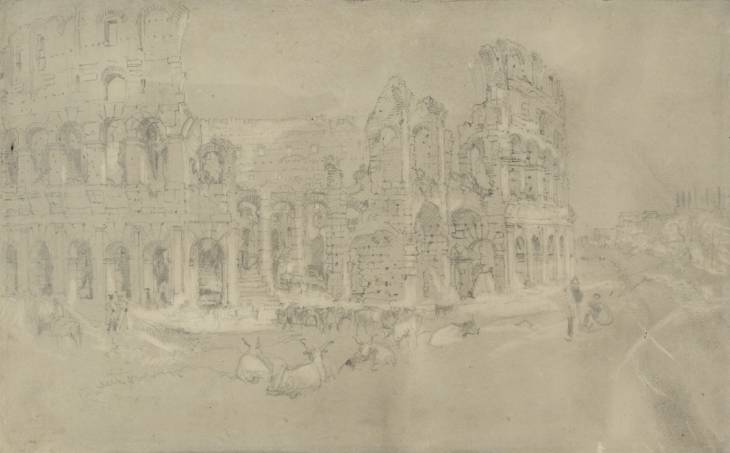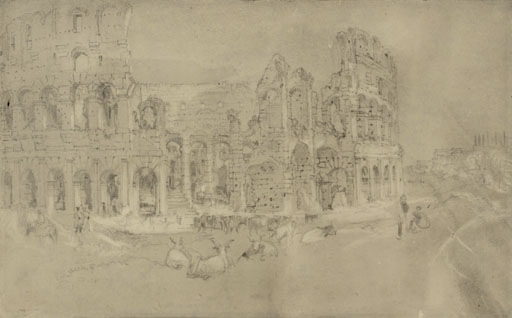Joseph Mallord William Turner The Colosseum, Rome, from the South 1819
Image 1 of 2
Joseph Mallord William Turner,
The Colosseum, Rome, from the South
1819
Joseph Mallord William Turner 1775–1851
The Colosseum, Rome, from the South 1819
D16349
Turner Bequest CLXXXIX 23
Turner Bequest CLXXXIX 23
Pencil and grey watercolour wash on white wove ‘Valleyfield’ paper, 230 x 368 mm
Stamped in black ‘CLXXXIX 23’ bottom right
Stamped in black ‘CLXXXIX 23’ bottom right
Accepted by the nation as part of the Turner Bequest 1856
Exhibition history
1904
National Gallery, London, various dates to at least 1904 (275).
1970
Turner: Watercolours Lent by the British Museum, Musée Provisoire d’Art Moderne, Brussels, November 1970–January 1971 (19, as ‘Le Colisée avec desc Chèvres’).
1975
Turner in the British Museum: Drawings and Watercolours, British Museum, London, May 1975–February 1976 (65, as ‘The Colosseum’).
1981
Turner’s First Visit to Italy, 1819: Watercolours from the Turner Bequest, Loaned by the British Museum, Tate Gallery, London, April–October 1981 (no catalogue).
1990
The Third Decade: Turner Watercolours 1810–1820, Tate Gallery, London, January–April 1990 (42, reproduced).
2007
Colour and Line: Turner’s Experiments, Tate Britain, London, April–November 2007 (no catalogue).
References
1903
Charles Holme, Robert de la Sizeranne, Walter Shaw Sparrow and others, The Genius of J.M.W. Turner, R.A., London, Paris and New York 1903, reproduced p.33, pl.56, as ‘The Colosseum, Rome’.
1904
E.T. Cook and Alexander Wedderburn (eds.), Library Edition: The Works of John Ruskin: Volume XIII: Turner: The Harbours of England; Catalogues and Notes, London 1904, no.275, pp.378, 622, as ‘Rome: The Colosseum, with Flock of Goats’.
1909
A.J. Finberg, A Complete Inventory of the Drawings of the Turner Bequest, London 1909, vol.I, p.562, as ‘The Colosseum, with flock of goats. 275, N.G.’.
1912
Alex[ander] J. Finberg, Turner’s Water-Colours at Farnley Hall, London 1912, p.XIV.
1920
D[ugald] S[utherland] MacColl, National Gallery, Millbank: Catalogue: Turner Collection, London 1920, p.87.
1959
Kenneth Clark, Michel Florisoone, Geoffrey Grigson and others, The Romantic Movement: Fifth Exhibition to Celebrate the Tenth Anniversary of the Council of Europe, exhibition catalogue, Tate Gallery and Arts Council Gallery, London 1959, pp.364–5 under no.444.
1970
Luke Herrmann, Turner: Watercolours Lent by the British Museum, exhibition catalogue, Musée Provisoire d’Art Moderne, Brussels 1970, no.19, pp.7, 17, as ‘Le Colisée avec desc Chèvres’.
1975
Andrew Wilton, Turner in the British Museum: Drawings and Watercolours, exhibition catalogue, British Museum, London 1975, no.65 pp.53, 57 under no.74, as ‘The Colosseum’.
1979
Andrew Wilton, The Life and Work of J.M.W. Turner, Fribourg 1979, p.383 under no.723.
1982
Andrew Wilton, Turner Abroad: France; Italy; Germany; Switzerland, London 1982, reproduced p.44 no.38, as ‘Rome: The Colosseum’.
1984
Cecilia Powell, ‘Turner on Classic Ground: His Visits to Central and Southern Italy and Related Paintings and Drawings’, unpublished Ph.D thesis, Courtauld Institute of Art, University of London 1984, p.227, reproduced pl.150, as ‘The Colosseum’.
1987
Cecilia Powell, Turner in the South: Rome, Naples, Florence, New Haven and London 1987, pp.107, 109, reproduced p.[108] pl.119, as ‘The Colosseum’.
1990
Diane Perkins, The Third Decade: Turner Watercolours 1810–1820, exhibition catalogue, Tate Gallery, London 1990, p.39 no.40, no.42 reproduced, as ‘Rome: The Colosseum’.
1998
Kim Sloan, J.M.W. Turner. Watercolours from the R.W. Lloyd Bequest in the British Museum, London 1998, p.82 under no.23 note 2.
2008
Nicola Moorby, ‘Un tesoro italiano: i taccuini di Turner’, in James Hamilton, Nicola Moorby, Christopher Baker and others, Turner e l’Italia, exhibition catalogue, Palazzo dei Diamanti, Ferrara 2008, pp.102, 105 note 28.
2009
Nicola Moorby, ‘An Italian Treasury: Turner’s sketchbooks’, in James Hamilton, Nicola Moorby, Christopher Baker and others, Turner & Italy, exhibition catalogue, National Galleries of Scotland, Edinburgh 2009, pp.115, 155 note 29.
Arguably the most famous of all the surviving monuments of classical Rome is the Flavian Amphitheatre, a huge building universally known as the Colosseum, which stands at the eastern end of the Roman Forum between the Palatine and Esquiline Hills. Built between 72–80 AD., the immense ruin was as popular with tourists during the eighteenth and nineteenth centuries as it is today, and its crumbling but impressive remains represented a constant source of inspiration for artists. Turner had read John Chetwode Eustace’s book, A Classical Tour Through Italy, which stated that ‘Never did human art present to the eye a fabric so well calculated by its size and form, to surprise and delight’ (see the Italian Guide Book sketchbook, Tate D13943; Turner Bequest CLXXII 7).1 Eustace recommended viewing the building first from the north, and then the south before finally visiting the interior.2 This sketch depicts a view of the southern façade of the building on the side of the Caelian Hill. During the early nineteenth century this face was in a state of considerable disrepair due to the removal of stone over the years for other building projects within the city (the wall was reconstructed in brick from the 1840s onwards). Turner shows us a glimpse of the interior seen through the ruined gaps in the wall and through the multiple arches of the tiers of arcades. In the background is the high back wall of the northern façade. As Cecilia Powell has discussed, Turner’s depiction was strongly influenced by eighteenth-century models such as the etchings of Giovanni Battista Piranesi.3 The overwhelming physical presence of the building, as well as the dramatic play of light and shadow recalls Piranesi’s plates for the Vedute di Roma.4
Like many drawings within this sketchbook, the composition has been executed in pencil over a washed grey background and Turner has created pale highlights by rubbing or lifting through to the white paper beneath. Following his 1819 tour, the sketch provided the basis for a finished watercolour, Rome: the Colosseum, 1820 (British Museum, London) bought by his great friend and patron, Walter Fawkes.5 The painting faithfully follows the design of the drawing in all respects apart from the transformation of the foreground cattle into goats, a different arrangement of figures, and the fact that Turner extends the scale of the Colosseum so that it entirely fills the picture plane. He also translated the tonal monochrome into a full coloured scheme, possibly based at least in part on other studies of the building from this sketchbook (see Tate D16345, D16346 and D16364; CLXXXIX 19, 20 and 37).
Turner’s 1819 sketchbooks demonstrate that he studied the Colosseum from a variety of viewpoints both inside and outside the celebrated structure.6 Sketches of the interior can be found in this sketchbook (see Tate D16339, D16380, D16389; Turner Bequest CLXXXIX 13, 51, 58) and in the Small Roman Colour Studies sketchbook (Tate D16414, D16416, D16417, D16420, D16421, D16451; Turner Bequest CXC 14a, 15a, 16, 18, 19, 38). Detailed or coloured studies of the exterior can be also found in this sketchbook (D16345, D16346,D16354, D16364, D16369; Turner Bequest CLXXXIX 19, 20, 28, 37, 42), in the Small Roman C. Studies sketchbook (Tate D16398; Turner Bequest CXC 4), and in the Albano, Nemi, Rome sketchbook (Tate D15397; Turner Bequest CLXXXII 53).
Verso:
Blank; inscribed by an unknown hand in pencil ‘CLXXXIX.23’ bottom centre right, and stamped in black ‘CLXXXIX 23’ bottom centre.
Nicola Moorby
July 2009
How to cite
Nicola Moorby, ‘The Colosseum, Rome, from the South 1819 by Joseph Mallord William Turner’, catalogue entry, July 2009, in David Blayney Brown (ed.), J.M.W. Turner: Sketchbooks, Drawings and Watercolours, Tate Research Publication, December 2012, https://www


